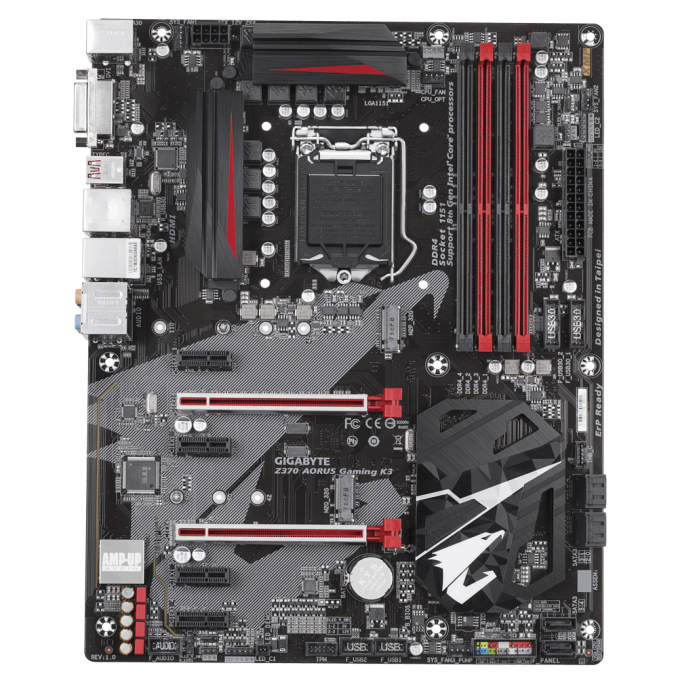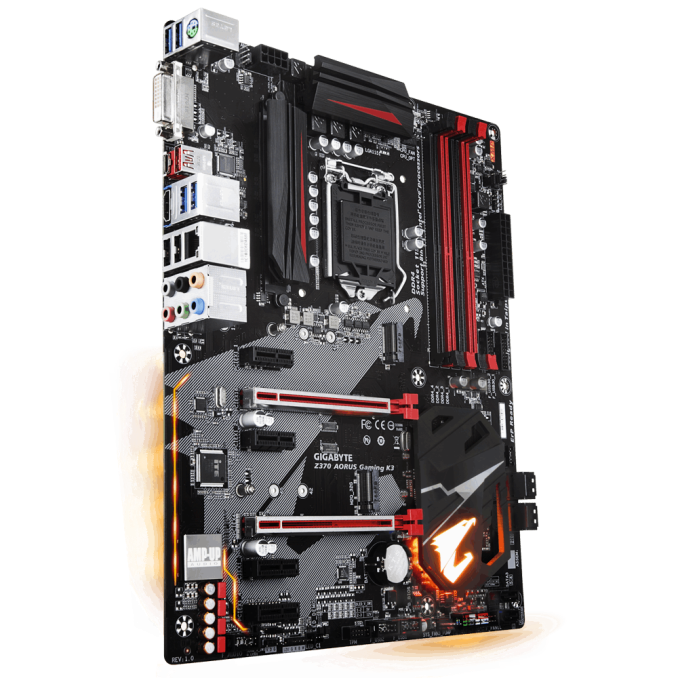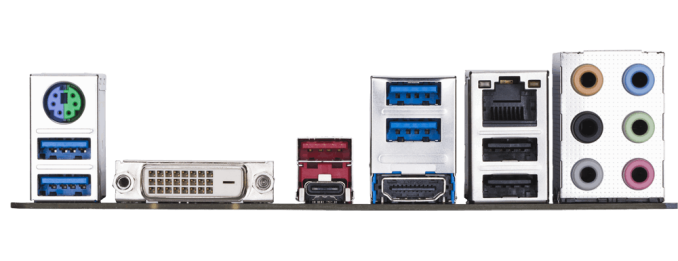Analyzing Z370 for Intel's 8th Generation Coffee Lake: A Quick Look at 50+ Motherboards
by Ian Cutress, Anton Shilov, Joe Shields & Gavin Bonshor on October 20, 2017 2:00 PM ESTGIGABYTE Z370 Gaming K3
The Z370 AORUS Gaming K3 motherboard fits in towards the bottom of the Gaming motherboards but has many of the features users need to be a solid gaming motherboard. Gone is the Killer E2500 NIC and replaced with an Intel I219-V chip. The back panel I/O adds a DVI output for onboard video connection but removes the OC button found on the Gaming 3. RGB Fusion support is still here along with RGBW headers, as well as keeping two M.2 slots.
Between the Gaming 3 and K3 there are few design changes between them. The black PCB and Falcon make its appearance along with the four DIMM slots alternating red and black. The biggest design difference between the two is the lack of a shroud to cover the I/O area. This is a small cost saving measure at the expense of a clean look around back panel IO as well as the RGB LEDs being relegated to the audio separation line and the PCH heatsink. Additional RGB LED strips can be added using any of the four headers (2 RGBW, two digital) all controlled by the RGB Fusion software.
The four memory slots and DDR4-4000 memory support matches the Gaming 3, and a capacity of up to 64GB is supported. The PCIe slot configuration is also the same as the Gaming 3, with four PCIe 1x slots fed from the chipset, and two full length, fortified slots running at x16/x4 with the x4 coming from the chipset. We again see Crossfire support, but not NVIDIA SLI.
The board has six SATA ports, with four located to the right of the PCH heatsink, and two facing vertically just below it and to the right of the front panel headers. The two M.2 slots are also in the same location as the Gaming 3 and support the same size drives. These are located just above the top PCIe 1x slot and just above the bottom full-length PCIe slot. Onboard audio is still handled by the Realtek ALC1220 codec, is shielded for EMI, has audio separation from the rest of the board, and uses the WIMA and Nichicon audio caps. In a cost-saving measure, the board uses an Intel-based NIC instead of the Killer Networks E2500 found on the Gaming 3. WiFi is not found on this board either. Thunderbolt 3 support is handled with an add-in card as well.
USB connectivity is a bit different here, at least on the USB 3.1 (5 Gbps) side. There are a total of eight possible USB 3.1 (5 Gbps) ports from four on the back panel and four available through internal USB headers. For USB2.0/1.1 there are six in total with two ports on the back panel and 4 ports available through the internal USB headers. The ASMedia 3142 controller handles the USB 3.1 (10 Gbps) Type-C and Type-A(red) ports found on the back panel. The back panel IO has a single PS/2 port, removes the OC button, and adds a DVI port. The audio stack does not have SPDIF.
The Z370 AORUS Gaming K3 has a few cost-saving measures compared to the Gaming 3 such as swapping the Killer NIC for Intel, and removing the back panel IO shroud, and secures its place a bit lower in the product stack. While fully featured, the lack of SLI support will have those with multiple NVIDIA GPUs looking at other products in the stack for the necessary support.













83 Comments
View All Comments
weevilone - Wednesday, October 25, 2017 - link
Notable that though the new boards are often very similar to their Z270 predecessors, Asus has dropped Thunderbolt 3 support from the Maximus X Hero board.masouth - Thursday, October 26, 2017 - link
ASUS ROG Z370 Maximus X Hero"....new metallic heat sinks that are an upgrade over the plastic heatsinks found on the Z270 version"
Please excuse my ignorance because I didn't own a ROG Z270 mb but...plastic HEAT SINKS? Not shrouds or decoration over a heat sink but the actual heat sinks themselves? That's either wrong, they performed their job pretty poorly, or plastic resins have advanced a lot farther in thermal conductivity (and cost for such) than I realized.
flowrush - Sunday, November 19, 2017 - link
"The other main distinguishable feature is the inclusion of integrated 802.11ac Wi-Fi with an antenna (that can only be described as a shark fin) found on the F."The above is incorrect in the article. The integrated Wi-Fi module with antenna is found on the E not the F.
Coldgame - Saturday, November 25, 2017 - link
I'm looking to build a rig with the Z370 Gaming ITX/ac, a GTX-1070 card and an Apple Thunderbolt Display.The review states:
"The key difference in the support between the two boards is going to be the Thunderbolt 3 port on the Gaming-ITX. This port supports video outputs..."
So, can anyone confirm or deny that video generated by the GTX-1070 can be output through the onboard Thunderbolt 3 port?
hanselltc - Sunday, December 3, 2017 - link
Looking forward to low-middle end mITX choices from this platform. It'll probably be paired with a 8100/8300 and be my secondary machine.Roen - Sunday, February 4, 2018 - link
Where are the 10 Gbps ports on the back? They all look like 5 Gbps ports, even the Type C.rbarak - Wednesday, February 21, 2018 - link
Is anyone using the Z370-P on Linux with two screens?I built a new machine based on the Z370-P, and both the DVI and the HDMI connected screens show the same image, and the RHEL7 setup/displays show only one Unknown Display.
I follwed the advice on stackexchange, and added this line:
$ grep GRUB_CMDLINE_LINE_DEFAULT /etc/default/grub
GRUB_CMDLINE_LINE_DEFAULT="i915.alpha_support=1"
Then I did:
sudo grub2-mkconfig -o "$(readlink /etc/grub2.conf)"
And rebooted, but still, the two displays are not shown.
dromoxen - Wednesday, May 9, 2018 - link
Shocked to see that both the Asrock mitx boards are "szie=ATX" .. LOLThe addition of Tunderbolt sure seems to add a hefty premium £120 vs £160 , luckily I can do without.
Kroebo - Sunday, October 7, 2018 - link
Sadly, I discovered that the ZUG Gaming PLUS doesn't support SLI.trag - Tuesday, January 15, 2019 - link
On the ASrock Z370M Pro4 the M.2 slot information is backwards. Both slots support NVME. One slot also supports SATA. As written, "The first M.2 slot is SATA only while the second supports PCIe." it seems to say that one slot is SATA only and the other slot is PCIe (NVME) only.